
It was an immense pleasure and honour for me to attend IATEFL conference 2019 at Liverpool, UK, and present my paper on ‘Teaching English Using Locally Made/ Available Materials’. My presentation was well-received by participants. As I look back at my feedback sheet, the comments such as ‘lovely-very creative, communicative and compelling’ by Sarah Moont and ‘very engaging’ by Sue Gorton demonstrate the enthusiasm the IATEFL participants had.
The use of locally made/available materials facilitates the English language teaching and learning more interesting, engaging and interactive. In this post, I present how we can use locally made/available materials to teach English. I’m glad to share this with those who did not attend my presentation in Liverpool.
The words in bold letters show what language items are focused to teach the learners. And you can always customize to fit your requirement and make your own versions. You will be amazed just with the following miniature items mentioned below, how much language we can teach.
Materials (miniature, realia) that were used:
Carpet, round cushion, square cushion, girl, boy, bed, mattress, pen, fish, broom, ten-rupee-note, sheet, pillow, card-stand showing 10 p.m., woman, quilt/duvet, ladder, mobile phone, log, rock, house, garden
A sample presentation technique:
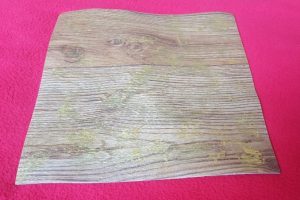 Hold the carpet toward the students and say ‘carpet’. Now say, ‘This is a carpet.’ (show it and say twice). As you lay the carpet on the floor, you can choose to say one of Hold the carpet toward the students and say ‘carpet’. Now say, ‘This is a carpet.’ (show it and say twice). As you lay the carpet on the floor, you can choose to say one of these:
Hold the carpet toward the students and say ‘carpet’. Now say, ‘This is a carpet.’ (show it and say twice). As you lay the carpet on the floor, you can choose to say one of Hold the carpet toward the students and say ‘carpet’. Now say, ‘This is a carpet.’ (show it and say twice). As you lay the carpet on the floor, you can choose to say one of these:
lay the carpet or spread the carpet or fit the carpet.
After you lay the carpet, you can roll back uttering either of these sentences:
Roll back the carpet or Roll up the carpet.
Now you can lift the carpet and beat it saying: beat the carpet.
Depending on what you want the learners to learn, you can modify the sentence and say, ‘I’m beating the carpet to dust off.’ (this expression could be in Nepali context where sometimes carpet needs beating to shed off the dust). If it is not the appropriate context in your situation, you can modify the language.
Before you ask your students to make their own version of language expressions, make sure that they have enough exposure what you do and what you say.
Example – 2
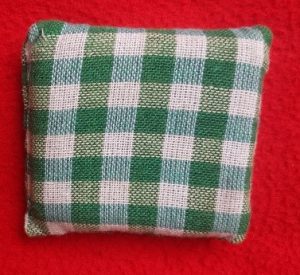
 Take the round cushion and say, ‘a round cushion’ before you say, ‘It’s a round cushion.’
Take the round cushion and say, ‘a round cushion’ before you say, ‘It’s a round cushion.’
Put the round cushion on the carpet and say: ‘The round cushion is on the carpet.’
Now take the square cushion
and say, ‘a square cushion’. Say again ‘It’s a square cushion’.
Put the square cushion on the carpet and say: The square cushion is on the carpet.
Now say this: Both
the round cushion and the square cushion are on the carpet-.
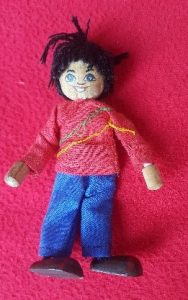
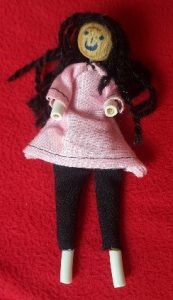 Hold the girl doll, show and say, ‘a girl’. Then say: She’s a student. Similarly, take the boy doll, show and say ‘a boy’ before saying the sentence: He’s a student too.
Hold the girl doll, show and say, ‘a girl’. Then say: She’s a student. Similarly, take the boy doll, show and say ‘a boy’ before saying the sentence: He’s a student too.
Place the girl on the round cushion and say:
The girl is sitting on the round cushion.
Then place the boy on the square cushion and say:
‘The boy is sitting on the square cushion.’ Now say this: Both the boy and the girl are sitting on the cushions.
The girl is sitting on the round cushion, whereas the boy is sitting on the rectangular cushion. Hold and show a bed and say –a bed-. Now say: It’s a bed. And now say: It’s 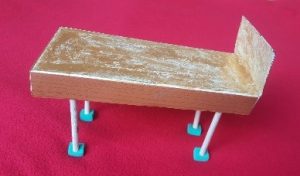 made of metal. Place the bed behind the girl and the boy and say: Behind the girl and the boy. ‘there’s a bed’.
made of metal. Place the bed behind the girl and the boy and say: Behind the girl and the boy. ‘there’s a bed’.
 Show pen and say, ‘a pen’. Now say: It’s a pen.
Show pen and say, ‘a pen’. Now say: It’s a pen.
Put the pen in front of the girl and say:
‘In front of the girl, there’s a pen.’
Also say this sentence:
‘There’s a pen in front of the girl.’
Show the fish and say- a fish. Now say – ‘It’s a fish.’
Next, put the fish in front of the boy and say:
‘There’s a fish in front of the boy’,
Next say this sentence:
‘There’s a fish in front of the boy.’
Then, utter this sentence: ‘There’s a pen in front of the girl, whereas there’s a fish in front of the boy.’
You can give other examples so that students can get ample opportunities to listen to and practice.
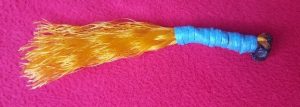 Show a broom and say ’a broom’. Now say:
Show a broom and say ’a broom’. Now say:
‘It’s a broom. It is used for sweeping the floor.‘
Now place the broom between the boy and the girl and say:
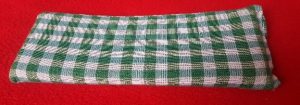 ‘The broom is between the boy and the girl.’
‘The broom is between the boy and the girl.’
Next, point toward the bed and say:
‘I’m gonna make the bed.’
Let’s do the same with mattress.
 Show mattress and say: a mattress. Now say: ‘It’s a mattress.’
Show mattress and say: a mattress. Now say: ‘It’s a mattress.’
Next, hold the mattress and press it with your fingers, and say: ‘The mattress is soft.’
Next, feel the metal bed and say: ‘But the bed is hard.’
Then, say this: ‘The mattress is soft whereas the bed is hard.’
Now show money and say ’money’. Say this: ‘This is money.’
If the money you are holding is a ten-rupee note, say ‘a ten-rupee-note’. Now say: ‘This is a ten-rupee note.’
(Note: Make sure that the students understand this clearly, and won’t say a ten-rupees note, which would be considered grammatically wrong.)
Now put the money under the mattress and say: ‘The money is under/beneath the mattress.’ You can also say: ‘I’m hiding the money under the mattress.’
You can also make the statement: ‘Some people hide their money under the mattress.’
Show bed sheet and say, ‘a bed sheet’. Now, say: ‘It’s a bed sheet.’ Lay the bed sheet and say: ‘I’ve laid the bed sheet’
Next, show the size and say: ‘It’s too big.’ Tuck in the bed sheet and say: ‘I’m tucking in the bed sheet.’
Show pillow and say, ‘a pillow’. Next, say: ‘This is a pillow.’
Next, put the pillow on the bed sheet and say: ‘I put the pillow on the bed sheet.’ quilt/duvet (a quilt/a duvet)
Now say: ‘It’s a quilt/It’s a duvet.’
Spread the quilt/duvet over the bed and say: ‘I spread the quilt/duvet over the bed.’ ‘It’s now ready. I’ve made the bed.”
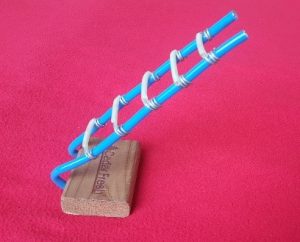 Show ladder and say –a ladder.
Show ladder and say –a ladder.
Now say: ‘It’s a ladder.’
Now show the rungs of the ladder and say ’rungs’. Now say –rungs of the ladder.
Finally say: ‘These are rungs of the ladder.’
Now place the ladder upright beside the bed and say: ‘The ladder is beside the bed.’
Show the time card stand and say: ‘It’s ten o’clock at night. It’s time to go to bed.’
And make a dramatic expression: ‘But I’m not going to bed.’ Show the doll of the
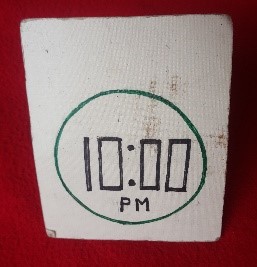 woman and say: This woman is going to bed. Now dramatically make the woman walk toward the ladder and say: The woman is walking towards the ladder.
woman and say: This woman is going to bed. Now dramatically make the woman walk toward the ladder and say: The woman is walking towards the ladder.
Now ask her to climb the ladder. Now you can say: She’s climbing up the ladder.” Make a dramatic stop as she reached the top rung of the ladder and say: She’s stopped on the top rung of the ladder. Why? Because she was too tired, and she forgot something. You know what she forgot? Show a mobile phone and say –her dear mobile phone. 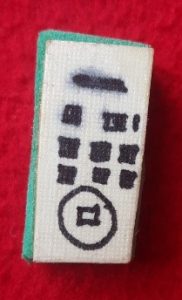
Place the mobile phone on the floor so that she has to climb down the ladder. As she is climbing down the ladder, you can say:
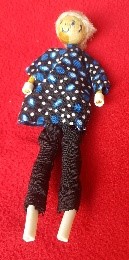 ‘She is climbing down the ladder. There’s some price to pay when you forget, isn’t there?’
‘She is climbing down the ladder. There’s some price to pay when you forget, isn’t there?’
Put the mobile phone under her arm and say:
‘She has put her mobile phone in her armpit to hold the mobile phone.’
Now ask her to climb up the ladder again and say:
‘She’s climbing up the ladder again. Poor absent-minded woman!’
Put the woman in the bed and pull the quilt over her and say these sentences: ‘She pulled the quilt/duvet.’
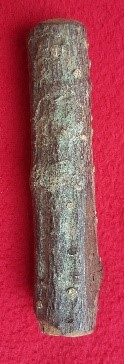 Now say, ‘She was too tired and now she’s fast asleep. She’s
Now say, ‘She was too tired and now she’s fast asleep. She’s 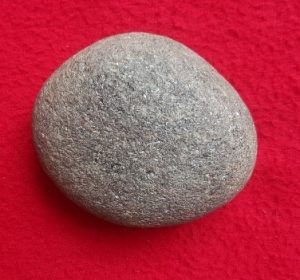 sleeping like a log/rock.’
sleeping like a log/rock.’
And now show a log and a rock and put on the floor, which are motionless. And again say: ‘The woman is sleeping like a log/a rock.’ Now say this: ‘And now she’s dreaming about a magnificent house with a beautiful garden.’ And place the house and the garden in front of it on the table.
Now you can also ask your students to make their own version of language using the items you used.
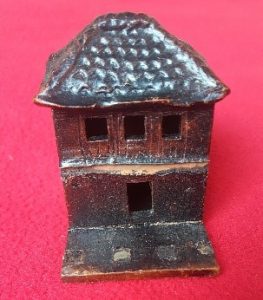
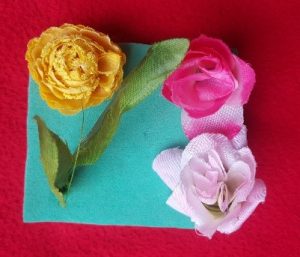
[Note: since you have come up to here reading the whole piece, please share your feeling, feedback or any question related to this article in the comment box below, which will encourage the author. Thank you!]
*The author is a freelance writer and a life member of Nepal English Language Teachers’ Association (NELTA).
[To cite this: Poudel. R.R., (2020, January 25). Teaching English using locally made/available materials [blog post]. Retrieved from: https://eltchoutari.com/2020/01/teaching-english-using-locally-made-available-materials/]